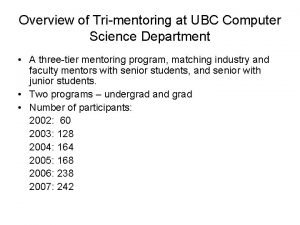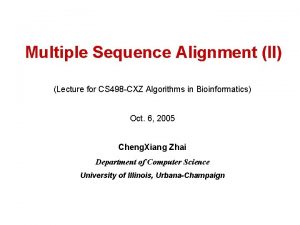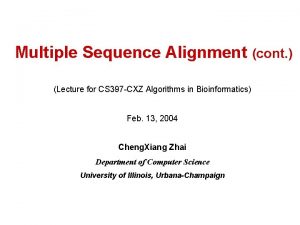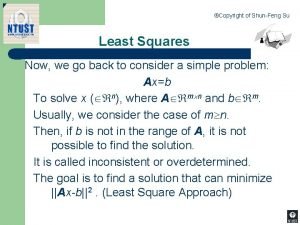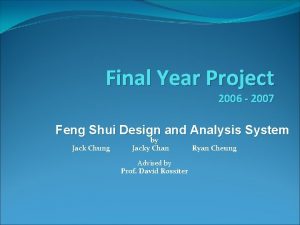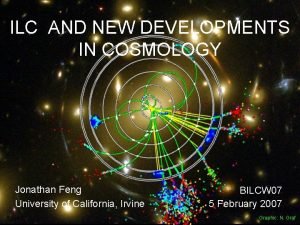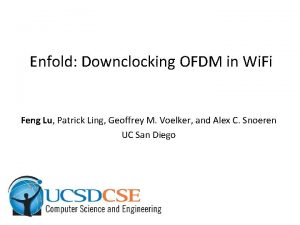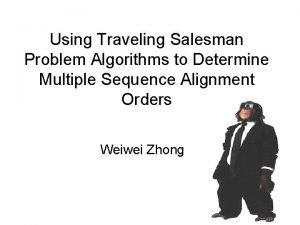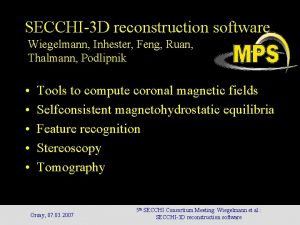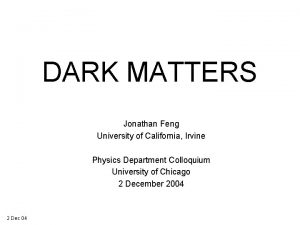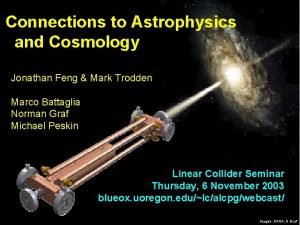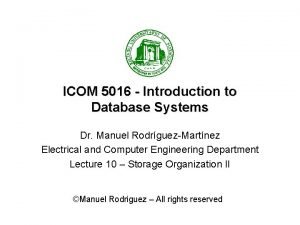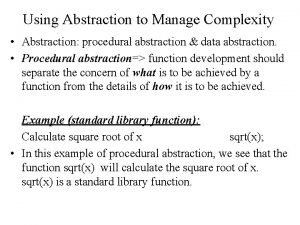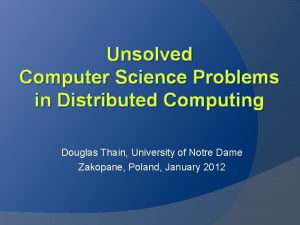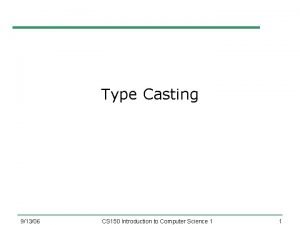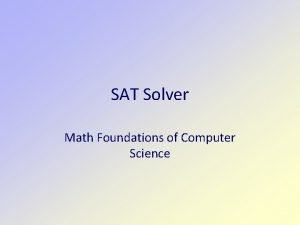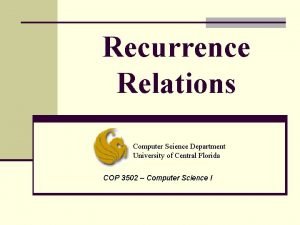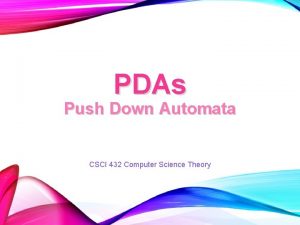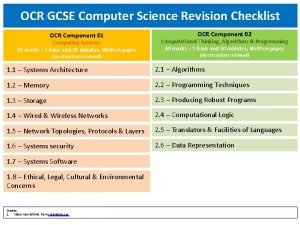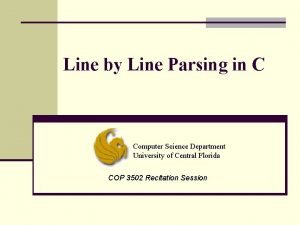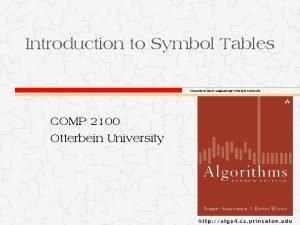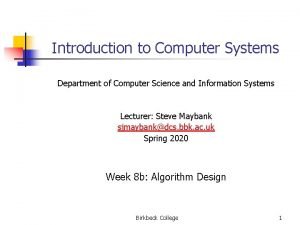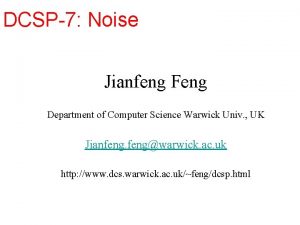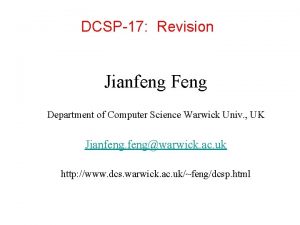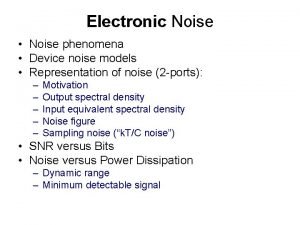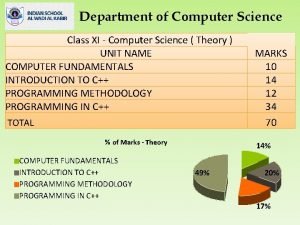DCSP5 Noise Jianfeng Feng Department of Computer Science

























![Generating f(x) from matlab X=randn(1, 1000); Plot(x); • X[1], x[2], …. X[1000], • Each Generating f(x) from matlab X=randn(1, 1000); Plot(x); • X[1], x[2], …. X[1000], • Each](https://slidetodoc.com/presentation_image/7cc2efb6f7b47f82d5e9f0b074c1bf3f/image-26.jpg)















![white noise w[n] • White noise is a random process we can not predict white noise w[n] • White noise is a random process we can not predict](https://slidetodoc.com/presentation_image/7cc2efb6f7b47f82d5e9f0b074c1bf3f/image-42.jpg)
![white noise w[n] • The most ‘noisy’ noise is a white noise since its white noise w[n] • The most ‘noisy’ noise is a white noise since its](https://slidetodoc.com/presentation_image/7cc2efb6f7b47f82d5e9f0b074c1bf3f/image-43.jpg)
































- Slides: 75

DCSP-5: Noise Jianfeng Feng Department of Computer Science Warwick Univ. , UK Jianfeng@warwick. ac. uk http: //www. dcs. warwick. ac. uk/~feng/dcsp. html

Assignment: 2015 • Q 1: you should be able to do it after last week seminar • Q 2: need a bit reading (my lecture notes) • Q 3: standard • Q 4: standard

Assignment: 2015 • Q 5: standard • Q 6: standard • Q 7: after today’s lecture • Q 8: load jazz, load Tunejazz load Noise. Jazz plot soundsc plot

Recap • Fourier Transform for a periodic signal { sim(n w t), cos(n w t)} • For general function case,

Recap: this is all you have to remember (know)? • Fourier Transform for a periodic signal { sim(n w t), cos(n w t)} • For general function case,

Dirac delta function Can you do FT for cos(2 p t)?

Dirac delta function For example, take F=0 in the equation above, we have It makes no sense !!!!

Dirac delta function: Ehrenfest Bragg A photo with the highest IQ (15 NL) Shordiger Heisenberg Dirac Compton Pauli Bone Debije De Boer M Curie Planck Einstein Lorentz Langevin

Dirac delta function: Ehrenfest Bragg A photo with the highest IQ (15 NL) Shordiger Heisenberg Dirac Compton Pauli Bone Debije De Boer M Curie Planck Einstein Lorentz Langevin

Dirac delta function The (digital) delta function, for a given n 0=0 here d(t)

Dirac delta function The (digital) delta function, for a given n 0=0 here Dirac delta function d(x) (you could find a nice movie in Wiki); d(t)

Dirac delta function d(x); The FT of cos(2 pt) is -1 0 1 Frequency

A final note (in exam or future) • Fourier Transform for a periodic signal { sim(n w t), cos(n w t)} • For general function case (it is true, but need a bit further work),

Summary Will come back to it soon (numerical) This trick (FT) has changed our life and will continue to do so

This Week’s Summary • Noise • Information Theory

Noise in communication systems: probability and random signals I = imread('peppers. png'); imshow(I); noise = 1*randn(size(I)); Noisy = imadd(I, im 2 uint 8(noise)); imshow(Noisy);

Noise in communication systems: probability and random signals I = imread('peppers. png'); imshow(I); noise = 1*randn(size(I)); Noisy = imadd(I, im 2 uint 8(noise)); imshow(Noisy);

Noise is a random signal (in general). By this we mean that we cannot predict its value. We can only make statements about the probability of it taking a particular value

pdf The probability density function (pdf) p(x) of a random variable x is the probability that x takes a value between x 0 and x 0 +dx. We write this as follows: p(x 0 )dx =P(x 0 <x< x 0 +dx) P(x) [x 0 x 0+ dx]

pdf Probability that x will take a value lying between x 1 and x 2 is The probability is unity. Thus

IQ distribution Mentally Inadequate 23% Low Intelligence Average 34. 1% 13. 6% Above Average 34. 1% High Superior Intelligence 13. 6% 2. 1% Exceptionally Gifted 0. 13%

pdf A density satifying the equation is termed normalized. The cumulative distribution function (CDF) F(x) is the probability x is less than x 0 My IQ is above 85% (F(my IQ)=85%).

pdf From the rules of integration: P(x 1<x<x 2) = P(x 2) --P(x 1) pdf has two classes: continuous and discrete

Continuous distribution An example of a continuous distribution is the Normal, or Gaussian distribution: where m, s is the mean and standard variation value of p(x). The constant term ensures that the distribution is normalized.

Continuous distribution. This expression is important as many actually occurring noise source can be described by it, i. e. white noise or coloured noise.
![Generating fx from matlab Xrandn1 1000 Plotx X1 x2 X1000 Each Generating f(x) from matlab X=randn(1, 1000); Plot(x); • X[1], x[2], …. X[1000], • Each](https://slidetodoc.com/presentation_image/7cc2efb6f7b47f82d5e9f0b074c1bf3f/image-26.jpg)
Generating f(x) from matlab X=randn(1, 1000); Plot(x); • X[1], x[2], …. X[1000], • Each x[i] is independent • Histogram

Discrete distribution. If a random variable can only take discrete value, its pdf takes the forms of lines. An example of a discrete distribution is the Poisson distribution

Discrete distribution.

We cannot predicate value a random variable Mean and variance We can introduce measures that summarise what we expect to happen on average. The two most important measures are the mean (or expectation) and the standard deviation. The mean of a random variable x is defined to be

Mean and variance • In the examples above we have assumed that the mean of the Gaussian distribution to be 0, the mean of the Poisson distribution is found to be l.

Mean and variance • The mean of a distribution is, in common sense, the average value. • Can be estimated from data • Assume that {x 1, x 2, x 3, …, x. N} are sampled from a distribution • Law of Large Numbers: EX ~ (x 1+x 2+…+x. N)/N

Mean and variance mean • The more data we have, the more accurate we can estimate the mean • (x 1+x 2+…+x. N)/N against N for randn(1, N)

Mean and variance • The variance is defined as The variance s is defined to be • The square root of the variance is called standard deviation. • Again, it can be estimated from data

Mean and variance • The standard deviation is a measure of the spread of the probability distribution around the mean. • A small standard deviation means the distribution are close to the mean. • A large value indicates a wide range of possible outcomes. • The Gaussian distribution contains the standard deviation within its definition (m, s)

Mean and variance • Communication signals can be modelled as a zero-mean, Gaussian random variable. • This means that its amplitude at a particular time has a PDF given by Eq. above. • The statement that noise is zero mean says that, on average, the noise signal takes the values zero.

Mean and variance http: //en. wikipedia. org/wiki/Nations_and_intelligence

Einstein’s IQ=160+ What about yours? Mentally Inadequate 23% Low Intelligence Average 34. 1% 13. 6% Above Average 34. 1% High Superior Intelligence 13. 6% 2. 1% Exceptionally Gifted 0. 13%

SNR • Signal to noise ratio is an important quantity in determining the performance of a communication channel. • The noise power referred to in the definition is the mean noise power. • It can therefore be rewritten as SNR= 10 log 10 ( S / s 2)

Correlation or covariance • Cov(X, Y) = E(X-EX)(Y-EY) • correlation coefficient is normalized covariance Coef(X, Y) = E(X-EX)(Y-EY) / [s(X)s(Y)] • Positive correlation, Negative correlation • No correlation (independent)

Stochastic process = signal • A stochastic process is a collection of random variables x[n], for each fixed [n], it is a random variable • Signal is a typical stochastic process • To understand how x[n] evolves with n, we will look at auto-correlation function (ACF) • ACF is the correlation between k steps

Stochastic process >> clear all close all n=200; for i=1: 10 x(i)=randn(1, 1); y(i)=x(i); end for i=1: n-10 y(i+10)=randn(1, 1); x(i+10)=. 8*x(i)+y(i+10); end plot(xcorr(x)/max(xcorr(x))); hold on plot(xcorr(y)/max(xcorr(y)), 'r') • two signals are generated: y (red) is simply randn(1, 200) x (blue) is generated x[i+10]=. 8*x[i] + y[i+10] • For y, we have g(0)=1, g(n)=0, if n is not 0 : having no memory • For x, we have g (0)=1, and g (n) is not zero, for some n: having memory
![white noise wn White noise is a random process we can not predict white noise w[n] • White noise is a random process we can not predict](https://slidetodoc.com/presentation_image/7cc2efb6f7b47f82d5e9f0b074c1bf3f/image-42.jpg)
white noise w[n] • White noise is a random process we can not predict at all (independent of history) • In other words, it is the most ‘violent’ noise • White noise draws its name from white light which will become clear in the next few lectures
![white noise wn The most noisy noise is a white noise since its white noise w[n] • The most ‘noisy’ noise is a white noise since its](https://slidetodoc.com/presentation_image/7cc2efb6f7b47f82d5e9f0b074c1bf3f/image-43.jpg)
white noise w[n] • The most ‘noisy’ noise is a white noise since its autocorrelation is zero, i. e. corr(w[n], w[m])=0 when • Otherwise, we called it colour noise since we can predict some outcome of w[n], given w[m], m<n

Sweety Gaussian Why do we love Gaussian?

Sweety Gaussian + Herr Gauss + Yes, I am junior Gaussian = Frau Gauss = Juenge Gauss • A linear combination of two Gaussian random variables is Gaussian again • For example, given two independent Gaussian variable X and Y with mean zero • a. X+b. Y is a Gaussian variable with mean zero and variance a 2 s(X)+b 2 s(Y) • This is very rare (the only one in continuous distribution) but extremely useful: panda in the family of all distributions

DCSP-6: Information Theory Jianfeng Feng Department of Computer Science Warwick Univ. , UK Jianfeng@warwick. ac. uk http: //www. dcs. warwick. ac. uk/~feng/dcsp. html

Data Transmission

Data Transmission How to deal with noise? How to transmit signals?

Data Transmission

Data Transmission Transform I • Fourier Transform • ASK (AM), FSK(FM), and PSK (skipped, but common knowledge) • Noise • Signal Transmission

Today • Data transmission: • Shannon Information and Coding: Information theory, • coding of information for efficiency and error protection;

Information and coding theory Information theory is concerned with • description of information sources • representation of the information from a source (coding) , • transmission of this information over channel.

Information and coding theory The best example how a deep mathematical theory could be successfully applied to solving engineering problems.

Information and coding theory Information theory is a discipline in applied mathematics involving the quantification of data with the goal of enabling as much data as possible to be reliably stored on a medium and/or communicated over a channel.

Information and coding theory The measure of data, known as information entropy, is usually expressed by the average number of bits needed for storage or communication.

Information and coding theory The field is at the crossroads of • • • mathematics, statistics, computer science, physics, neurobiology, electrical engineering.

Information and coding theory Impact has been crucial to success of • voyager missions to deep space, • invention of the CD, • feasibility of mobile phones, • development of the Internet, • the study of linguistics and of human perception, • understanding of black holes, and numerous other fields.

Information and coding theory Founded in 1948 by Claude Shannon in his seminal work A Mathematical Theory of Communication

Information and coding theory • The ‘bible’ paper: cited more than 60, 000

Information and coding theory The most fundamental results of this theory are 1. Shannon's source coding theorem the number of bits needed to represent the result of an uncertain event is given by its entropy; 2. Shannon's noisy-channel coding theorem reliable communication is possible over noisy channels if the rate of communication is below a certain threshold called the channel capacity. The channel capacity can be approached by using appropriate encoding and decoding systems.

Information and coding theory The most fundamental results of this theory are 1. Shannon's source coding theorem the number of bits needed to represent the result of an uncertain event is given by its entropy; 2. Shannon's noisy-channel coding theorem reliable communication is possible over noisy channels if the rate of communication is below a certain threshold called the channel capacity. The channel capacity can be approached by using appropriate encoding and decoding systems.

Information and coding theory Consider to predict the activity of Prime minister tomorrow. This prediction is an information source.

Information and coding theory Consider to predict the activity of Prime Minister tomorrow. This prediction is an information source X. The information source X ={O, R} has two outcomes: • He will be in his office (O), • he will be naked and run 10 miles in London (R).

Information and coding theory Clearly, the outcome of 'in office' contains little information; it is a highly probable outcome. The outcome 'naked run', however contains considerable information; it is a highly improbable event.

Information and coding theory An information source is a probability distribution, i. e. a set of probabilities assigned to a set of outcomes (events). This reflects the fact that the information contained in an outcome is determined not only by the outcome, but by how uncertain it is. An almost certain outcome contains little information. A measure of the information contained in an outcome was introduced by Hartley in 1927.

Information Defined the information contained in an outcome xi in x={x 1, x 2, …, xn} I(xi) = - log 2 p(xi)

Information The definition above also satisfies the requirement that the total information in in dependent events should add. Clearly, our prime minister prediction for two days contain twice as much information as for one day.

Information The definition above also satisfies the requirement that the total information in in dependent events should add. Clearly, our prime minister prediction for two days contain twice as much information as for one day X={OO, OR, RO, RR}. For two independent outcomes xi and xj, I(xi and xj) = - log 2 P(xi) P(xj) = - log 2 P(xi) - log 2 P(xj)

Entropy The measure entropy H(X) defines the information content of the source X as a whole. It is the mean information provided by the source. We have H(X)= Si P(xi) I(xi) = - Si P(xi) log 2 P(xi) A binary symmetric source (BSS) is a source with two outputs whose probabilities are p and 1 -p respectively.

Entropy The prime minister discussed is a BSS. The entropy of the BBS source is H(X) = -p log 2 p - (1 -p) log 2 (1 -p)

Entropy. When one outcome is certain, so is the other, and the entropy is zero. As p increases, so too does the entropy, until it reaches a maximum when p = 1 -p = 0. 5. When p is greater than 0. 5, the curve declines symmetrically to zero, reached when p=1.

Next Week • Application of Entropy in coding • Minimal length coding

Entropy We conclude that the average information in BSS is maximised when both outcomes are equally likely. Entropy is measuring the average uncertainty of the source. (The term entropy is borrowed from thermodynamics. There too it is a measure of the uncertainly of disorder of a system). Shannon: • My greatest concern was what to call it. • I thought of calling it ‘information’, but the word was overly used, so I decided to call it ‘uncertainty’. • When I discussed it with John von Neumann, he had a better idea. • Von Neumann told me, ‘You should call it entropy, for two reasons. • In the first place your uncertainty function has been used in statistical mechanics under that name, so it already has a name. • In the second place, and more important, nobody knows what entropy really is, so in a debate you will always have the advantage.

Entropy In Physics: thermodynamics The arrow of time (Wiki) • Entropy is the only quantity in the physical sciences that seems to imply a particular direction of progress, sometimes called an arrow of time. • As time progresses, the second law of thermodynamics states that the entropy of an isolated systems never decreases • Hence, from this perspective, entropy measurement is thought of as a kind of clock

Entropy
 Saharsa college of engineering
Saharsa college of engineering Noise
Noise Ucl bsc computer science
Ucl bsc computer science Northwestern university computer engineering
Northwestern university computer engineering Computer science department rutgers
Computer science department rutgers Vptl tutoring stanford
Vptl tutoring stanford Florida state university masters in computer science
Florida state university masters in computer science Ubc computer science department
Ubc computer science department Bhargavi goswami
Bhargavi goswami Computer science department columbia
Computer science department columbia His favourite subject is
His favourite subject is Feng doolittle algorithm
Feng doolittle algorithm Feng doolittle algorithm
Feng doolittle algorithm Feng guo symmetry
Feng guo symmetry Kaveh razavi
Kaveh razavi Cuatro pilares viento y agua
Cuatro pilares viento y agua Shun-feng su
Shun-feng su Feng yuan microsoft
Feng yuan microsoft Feng shui
Feng shui Wayne feng
Wayne feng Feng shui floor plan analysis
Feng shui floor plan analysis Feng ru death
Feng ru death Claudette morel age
Claudette morel age Feng suave vpro
Feng suave vpro Dr connie feng
Dr connie feng Benefits of feng shui
Benefits of feng shui Pupuk feng shou untuk ternak
Pupuk feng shou untuk ternak Zuo-feng zhang
Zuo-feng zhang Jonathan feng white & case
Jonathan feng white & case Ia64 processor
Ia64 processor Feng lu
Feng lu Feng doolittle algorithm
Feng doolittle algorithm Feng ruan
Feng ruan Jonathan feng
Jonathan feng Jonathan feng white & case
Jonathan feng white & case Department of forensic science dc
Department of forensic science dc Oh.nesinc
Oh.nesinc Iit delhi polymer science
Iit delhi polymer science Tum
Tum Computer engineering department
Computer engineering department Social science vs natural science
Social science vs natural science What are the three branches of science
What are the three branches of science Natural science vs physical science
Natural science vs physical science Applied science vs pure science
Applied science vs pure science Anthropology vs sociology
Anthropology vs sociology Science fusion digital lessons
Science fusion digital lessons Rule of 70 in population growth
Rule of 70 in population growth Julie lundquist
Julie lundquist Hard science and soft science
Hard science and soft science Wjec gcse computer science
Wjec gcse computer science University of phoenix computer science
University of phoenix computer science How many fields in computer science
How many fields in computer science Procedural abstraction examples
Procedural abstraction examples Computer science unsolved problems
Computer science unsolved problems University of bridgeport computer science faculty
University of bridgeport computer science faculty Bridgeport university computer science
Bridgeport university computer science Sequencing apcsp
Sequencing apcsp Ucl computer science interview
Ucl computer science interview Casting computer science
Casting computer science Predicate computer science
Predicate computer science Computer science illuminated (doc or html) file
Computer science illuminated (doc or html) file Konsep dasar logika himpunan
Konsep dasar logika himpunan Yonsei computer science
Yonsei computer science Sat in computer science
Sat in computer science Ib computer science topic 6
Ib computer science topic 6 Data representation computer science
Data representation computer science Recursion ap computer science
Recursion ap computer science Recurrence computer science
Recurrence computer science Pda in computer science
Pda in computer science Anticipating misuse computer science
Anticipating misuse computer science Worksheet 2 searching algorithms answers
Worksheet 2 searching algorithms answers Parse computer science
Parse computer science Undecidable problems in computer science
Undecidable problems in computer science Otterbein computer science
Otterbein computer science What is iteration in computer science
What is iteration in computer science Computer science vu
Computer science vu







